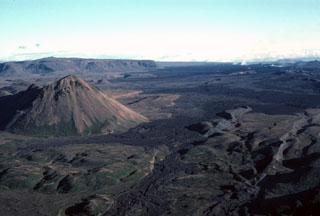Report on Krafla (Iceland) — February 1980
Scientific Event Alert Network Bulletin, vol. 5, no. 2 (February 1980)
Managing Editor: David Squires.
Krafla (Iceland) Small deflation event; magma migrates 7 km S
Please cite this report as:
Global Volcanism Program, 1980. Report on Krafla (Iceland) (Squires, D., ed.). Scientific Event Alert Network Bulletin, 5:2. Smithsonian Institution. https://doi.org/10.5479/si.GVP.SEAN198002-373080
Krafla
Iceland
65.715°N, 16.728°W; summit elev. 800 m
All times are local (unless otherwise noted)
"The gradual inflation after the minor December event was reversed about 1 February, when very slow deflation began and the earthquake activity associated with inflation stopped. As measured at the Krafla power house, the initial deflation rate of about 0.5 µrad/day increased on 7 February to about 1.3 µrad/day. In the evening of 10 February, a dense microearthquake swarm began near the S rim of the Krafla caldera and started to propagate southward. At about the same time, the deflation rate increased at Krafla, reaching a maximum of 7 µrad/day on 12 February. The rate of deflation decreased gradually thereafter; on 17 February it stopped and on 21 February inflation started again. The total deflation of 40 µrad is somewhat larger than the December deflation but still only about 1/6 of the last major deflation-rifting event in May 1979 (4:5).
"The active zone extended 7 km S from the rim of the caldera. The same part of the fault swarm was activated during two deflation/rifting events in 1977. This time, the earthquakes were significantly deeper in the crust than in the earlier events in that area. No earthquakes reached magnitude 3 but many were felt and heard in villages near Mývatn (~10 km SW of Krafla). Movements of faults over the seismically active area were very minor and the geodimeter lines near the S end of the active zone showed no significant movement."
Geological Summary. The Krafla volcanic system in the Northern Volcanic Zone (NVZ) of Iceland is about 100 km long, consisting of a fissure swarm and a central volcano with a 7 x 9 km caldera formed about 110,000 years ago that deposited a rhyolitic welded tuff. It has been moderately active in the Holocene, over three distinct eruptive periods; the current one has lasted about 2,800 years with six volcano-tectonic episodes, each with one or more basaltic fissure eruptions. Lava volumes (DRE) have been in the 0.1-1 km3 range. The Hverfjall and Ludent tuff rings east of Myvatn were erupted along the fissure system. Myvatn lake formed during the eruption of the older Laxarhraun lava flow from the Ketildyngja shield volcano of the Fremrinamur volcanic system about 3,800 years before present (BP); The present Myvatn lake is constrained by the roughly 2,000 years BP younger Laxarhraun lava flow from the Krafla volcanic system. The abundant pseudocraters that form a prominent part of the Myvatn landscape were created when the younger Laxarhraun lava flow entered the lake. The last eruption took place in 1975-1984 CE when nine small basaltic fissure eruptions produced 0.25 km3 of lava.
Information Contacts: K. Grönvold, NVI; P. Einarsson, Univ. of Iceland.

